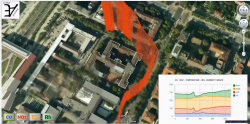EVERYAWARE: Measuring your way to a healthier environment
The EVERYAWARE(opens in new window) project embraced the challenge of helping people to work out exposure to air pollution and make informed choices regarding the best times to be out and about, all this with a cheap, reliable and easy to use equipment. Five partners(opens in new window) joined their expertise, from social to computer and environment sciences. €2 million of EU funding was invested in the project to create the tools and organise various case studies. Two smartphone apps were developed: AirProbe to monitor exposure to air pollution and Widenoise to measure noise levels. Both apps include social games to share information and impressions as well as interactive maps. ENGAGING CITIZENS WITH AIRPROBE The AirProbe app, which is not yet available to the public, works in conjunction with a small battery-operated sensor box that can easily be carried in a knapsack or bicycle basket. This connects to the phone via Bluetooth. After sucking in air, the box sends readings rating the level of ozone, black carbon and other pollutants to a central server, which then bounces helpful information about the town’s polluted areas as well as peak pollution times to avoid. ‘AirProbe is easy for everyone to use and realising just what we are breathing can be a real eye-opener,’ says EVERYWHERE project coordinator Vittorio Loreto(opens in new window) , a research leader at ISI Foundation in Turin and a physics professor at Sapienza University of Rome. Not only will the apps help vulnerable people such as children, the elderly and asthma sufferers to make healthy choices, but they are also fun to use, making their uptake more probable. During the project, researchers recruited people to test the AirProbe app and sensor box by launching challenges in four cities – London, Antwerp, Kassel and Turin. This allowed interested members of the public to become Air Ambassadors, recording levels of pollutants at various locations. SCIENCE ON THE GO Scientists can also use the information gathered to analyse pollution trends and post this information online for urbanites and public authorities. This could serve, for example, for combating traffic congestion. ‘It is still too early to draw any conclusions, but it will be interesting to see how people change their behaviour as their awareness of the environment increases,’ says Professor Loreto. Once the sensor box is available at a larger scale, AirProbe users will be able to access Experimental Tribe and the various games – which can give social scientists unique insights into human behaviour and decision-making. MAKING THE TECHNOLOGY AVAILABLE TO ALL ‘For the time being, I imagine a much smaller, ideally wearable sensor box integrated into our clothes and objects,’ says Professor Loreto. ‘The integration with the smartphones is of course also envisioned, though on a longer timescale. It all depends on which companies are interested in producing the sensor box, and how much smartphone makers are willing to invest,’ he said. Once the sensor box is made available to the broader public, it is expected to lead to the release of several apps similar to AirProbe, as well as online game platforms akin to Experimental Tribe using EVERYAWARE’s open-source technology. ‘If you want to have innovation, you have to give everyone the possibility to build on what you have constructed,’ says Professor Loreto. ‘The next step will be to find someone who can mass-produce the sensor box so that everyone has the opportunity to buy and use it.’ Link to project on CORDIS(opens in new window) Link to project's website(opens in new window) Link to the application Widenoise on Google Play(opens in new window) Widenoise on the App Store(opens in new window) Link to related video(opens in new window)



